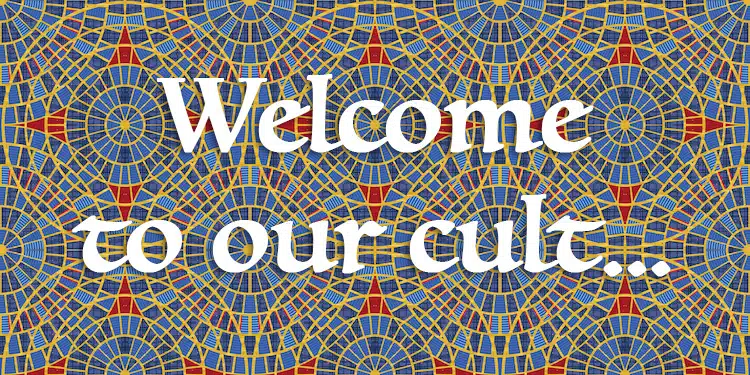
In “The Dragon Con Experience, Part 1,” I looked at how Dragon Con grew from a tiny seed planted by Atlanta-area sci-fi and fantasy fans back in 1987. Then, in “Part 2,” I gave the briefest look at the unique things to expect when attending Dragon Con. I’ll wrap up this series with this look at the cultish behavior that has grown out of our shared Dragon Con experiences.
If you, like me, are a “fan” (“fanatic”) of something in the media landscape, you know how passionate we can be, to the point of forming tribes around our fandoms. In the 80s and early 90s, conventions like Dragon Con were essential for finding and connecting with our tribes. By the late 90s and early 00s, the internet merged small local tribes into larger global communities. Conventions grew as those communities traveled the world to nerd out together.
So what happens when we stuff all that nerdy emotion and energy into one place? Inevitably, we codify our own set of fanatical religious behaviors. Each of us is enraptured by the things we love from both broader pop culture (like TV, movies, and games) and niche interests (like costuming, filk music, and space exploration). Together, we adopt traditions and rituals to channel that energy into unique, memorable experiences.
Dragon Con is a nexus of such traditions and rituals. Because of its organic growth and enormous size, Dragon Con has evolved to be more like a religious pilgrimage than a fan convention. The con pulls in fans of hundreds of different things, but we’re all connected by the places, events, and phenomena of one singular experience. Even strangers who have attended at least once in the last two decades share a common understanding of the Dragon Con experience. In short, Dragon Con has formed its own tribe with a language and culture of its own.

As fans are wont to do, Dragon Con fans are eager to have and do things that represent our fandom. Beyond the usual con mementos like T-shirts and tote bags, this includes the Dragon Con badge. There’s new stunning badge artwork each year, making the badge quite the memento. What’s more is that all kinds of people around the con hand out ribbons that attendees can attach to their badges, each representing some particular encounter they had during the convention.
Beyond the badges, those of us who have been baptized into the Dragon Con faith have other mementos. One is proof that we played the Host Hotel Hunger Games and got into a rare (and expensive) room at one of the Dragon Con host hotels (covered in Part 1). That proof comes in the form of specially designed hotel room keys, which we can keep after our stay. Each hotel has its own design, too, so those who have the coveted Marriott key are truly special indeed!

Beyond the badges and hotel keys, there is a deeper layer of evidence that shows we’re Dragon Con aficionados with a wealth of knowledge and experience! That layer is taking part in the traditions, memes, and events involving one of Dragon Con’s many ritualistic cults. There are too many cults to cover here, but I’ll take you on a quick tour of some you’ll want to know if you join the current Dragon Con fandom.

Currently, Dragon Con’s most prolific cult is the Cult of the Marriott Carpet. Seriously, enter “Marriott Carpet” in a Google search, and you’ll see exactly what I mean. The Atlanta Marriott Marquis became a central hub for Dragon Con after joining the Hyatt as a host hotel in 2001. As a result, con-goers often associate the Marriott’s unique architecture with the annual event. So, it’s no surprise that when the hotel chose a new, bright, eye-catching design for its floors in 2007, con-goers treated the carpet itself as its own special guest at the convention. For eight years, having the carpet in photos from Dragon Con became a way to solidify that “you were there.”
But the cult as we know it today didn’t take form until Dragon Con fans were stirred to avenge their own. It started in 2013 when professional cosplayers Harrison Krix of Volpin Props and Bill Winans of Angry Dog Studios created infantry soldier outfits with carpet-patterned camouflage. (I was there and was amazed by their brilliance!) Photos and videos of their cosplay went viral online, and Krix openly shared the graphic he had created for the costumes on Spoonflower, a website for ordering fabrics and items printed with a specific pattern. Dragon Con enthusiasts launched plans to incorporate the pattern into their own costumes, casual wear, bags, and more.

Within two weeks, though, Krix received a Cease and Desist order from Couristan, Inc., the carpet designer. Krix removed his parody design from Spoonflower, but news of the incident went viral, especially among cosplayers. What Couristan didn’t seem to understand was that telling fans not to do something is a surefire way to get them to go all-in! Sure enough, in the years that followed, Dragon Con cosplayers and other creatives passed around graphics files and shared links to sites like Spoonflower, Redbubble, and Etsy, where people could grab fabric and other items printed with designs mimicking the carpet’s colorful pattern.
Sadly, just two years later, the Marriott announced that it would be replacing the iconic carpet. Dragon Con fans led the effort in 2015-16 to seek out remnants of the carpet as it was removed. You can still find people swapping remnants online. Honoring the loss, Dragon Con Eternal member “Eternal Zan” Bowden formed a group dubbing itself the Cult of the Marriott Carpet with the motto “You Can’t Pull the Rug Out from Under Us!” The group reserves a spot in the Dragon Con parade each year, giving people a showcase for their carpet-inspired creations. I’ve seen everything from formal gowns to superhero costumes to car wraps incorporating the pattern.
The Marriott itself now embraces the carpet cult as part of its own brand. It welcomes visitors into the hallway behind the registration desk to see where some of that carpet still remains. The hotel even uses the carpet pattern for marketing during Dragon Con, which we saw in 2023 on the digital marquee screens throughout the hotel.

The Marriott’s architecture creates natural high-traffic routes during Dragon Con. One of those routes includes curved staircases that are one way to descend to the level that has the con’s Walk of Fame (celebrity guest booths) and various booths promoting bands, clubs, and Atlanta-area events. In past years, at the bottom of one of those curved staircases stood a lone trash can full of dreams and discarded beverage cups.
Then, in 2014, a satirical post in Dragon Con’s official Facebook group announced that the trash can would not be there for the next con, instead being replaced by some better-placed trash cans in nearby areas. The poster said, “I don’t know that I’m going to go this year, it obviously just isn’t the con I have come to love over all these years.” The satire caught on in Dragon Con’s online tribe, and many joined in lamenting the loss of the trash can as if it were some beloved community member.
When memes about the trash can went viral, it was dubbed “Trashy.” Across social media, people posted memorial photos at Trashy’s location, honoring the lost waste bin. Typical photos included people kneeling or pretending to weep, some holding memorial signs or photos of the overfilled trash can in its prime. One year, someone began placing an “altar” for Trashy at its location: a cardboard box with a black trash bag and a printed sign saying “Trashy.”
The Trashy photo op became a Dragon Con ritual, and I have posed in a few such photos myself over the years. The earliest photos included the Marriott Carpet on the floor, which had become iconic following the 2013 cosplay incident. Since the carpet’s removal, memorial photos now often include tributes to the Marriott Carpet.
After taking two years off from attending Dragon Con, I returned in 2019 to find the cults and traditions as strong as ever. One such tradition involves what I call “guerilla googly-eyes placement.” It’s a minor form of vandalism in which con-goers stealthily add sticky-backed googly eyes to marketing signs around the con. When I had my legacy room in the Hilton, it was an annual expectation to see googly eyes on the sexy lady in the Trader Vic’s ad in each elevator.
That year, the FedEx office in Peachtree Plaza had a cardboard stand-up advertising its services. It included a life-size cutout of a clean-cut man dressed in a FedEx delivery uniform. The stand-up was placed in the high-traffic hallways connecting the Marriott with the Peachtree Center food court. The googly-eye vandals struck first, giving the cutout an amusing gaze to everyone who passed. Then, each time we passed the cutout over the next couple of days, some additional form of vandalism had been committed on the stand-up: a lei, stickers, a mustache, and so much more!

Word quickly spread around the con that the crowd was calling the FedEx guy “Jon.” Then, what was once a target of vandalism quickly switched to a religious icon. By the last day of the con (Monday), Jon had disappeared, and attendees began leaving all kinds of geeky offerings where the sign once stood. It became the nerd version of a Buddhist temple shrine. A Cult of Jon Facebook group sprung up where those who experienced this historical event shared photos and memes. Oh yeah, and the wife of the male model who was used for that image (whose name is NOT Jon) found the group and shared that her husband actually found it quite funny!
Dragon Con was online-only during the pandemic in 2020, and I skipped 2021. However, on my return in 2022, it was a delight to see that the Cult of Jon was still a thing: people placing religious-style icons around the FedEx drop boxes in the hallway, and a few cosplayers donning FedEx shirts, leis, and googly eyes to honor the cardboard legend.
I’ve covered some of the heavy hitters when it comes to Dragon Con cults and culture, but I’m sure my list will become outdated as new cults emerge over time. Facebook user Joshua Thomas set up a small group in 2020 to acknowledge Dragon Con’s religious diversity and to help us celebrate together across all the cults: the Unified Church of the Dragons.
Leave it to a bunch of fanatics to build out their own pockets of subculture based on their memorable experiences of this pop culture phenomenon! Have you been to Dragon Con, too? If so, what are your favorite memories of the cults and culture? I leave you with this excellent video talking about fandom and identity through the lens of Dragon Con cults:




This is so fun! Thanks for sharing.